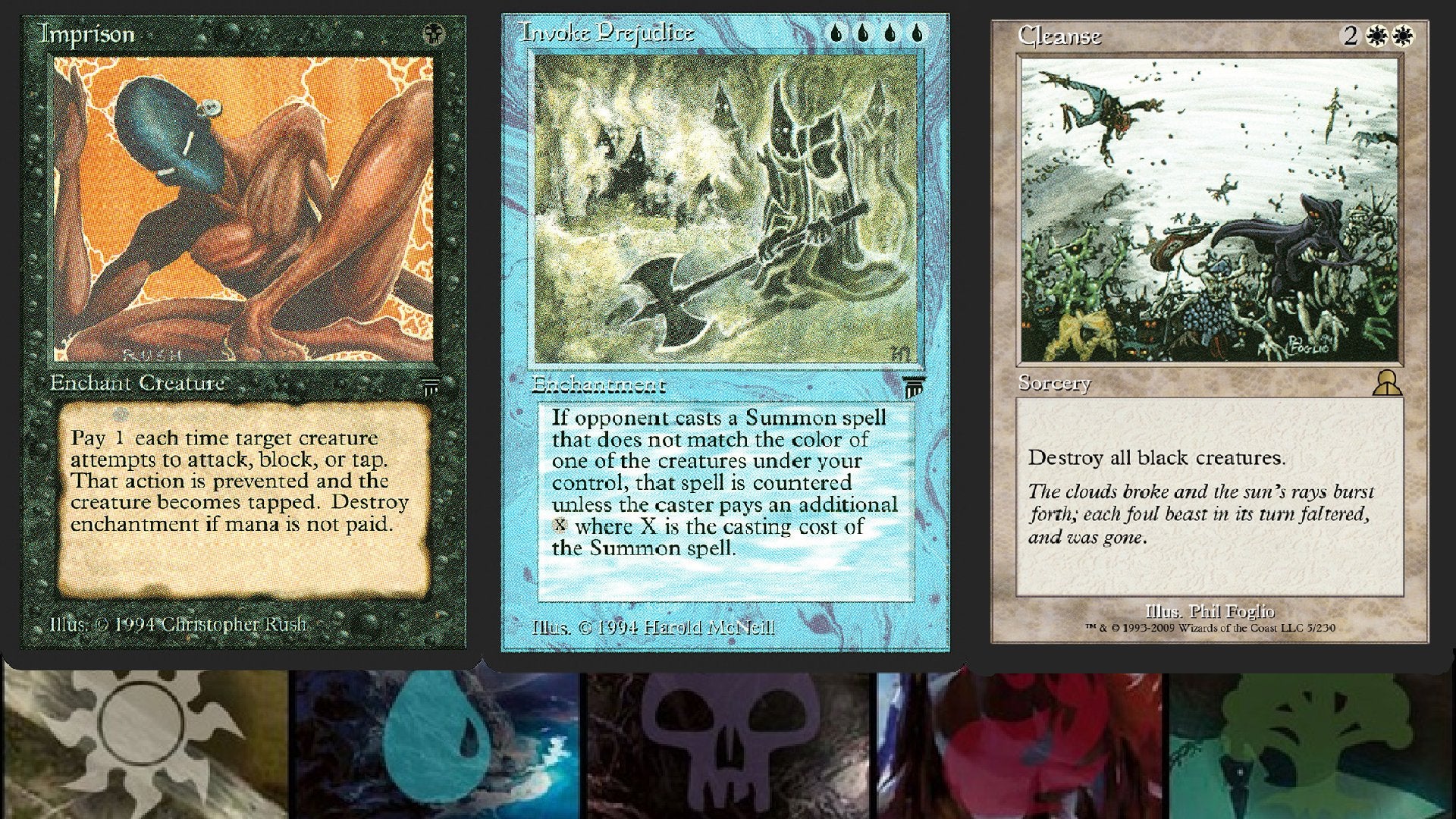![]() Key Takeaway
Key Takeaway
Here’s every MTG card that’s been banned for cultural insensitivity—as well as the expansion or set they were released in and their print year:
- Stone-Throwing Devils (Arabian Nights) 1993
- Jihad (Arabian Nights) 1993
- Pradesh Gypsies (Legends) 1994
- Imprison (Legends) 1994
- Crusade (Alpha) 1993
- Cleanse (Legends) 1994
- Invoke Prejudice (Legends) 1994
Companies are more and more concerned about cultural sensitivity these days. However, before this was the norm, even the biggest names in gaming media made some reprehensible decisions, including Magic: The Gathering. In MTG, some arguably racist cards were printed in the 90s—though they’ve since been banned.
Table Of Contents
Every Card Banned for Being Racist in Magic: The Gathering, Ranked Video
About This List
We’re only going to cover the cards that have been officially and irrevocably banned. As in these are cards that have been released and then removed from the gaming scene through becoming disallowed in every format.
We’re not covering cards that were withheld before release due to last-minute decisions, artist associations, or those that have been retconned. On top of that, we’ll be listing them in the order of least to most offensive.
Stone-Throwing Devils
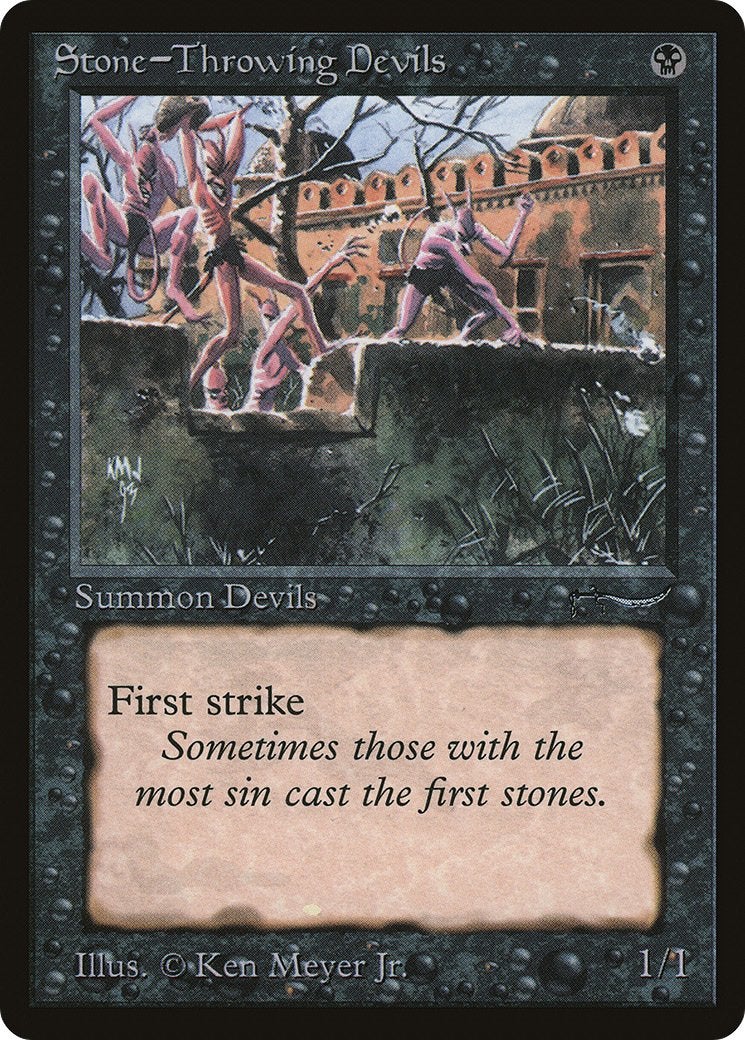
Stone-Throwing Devils was released in MTG’s first-ever expansion: Arabian Nights. This expansion was released in 1993 and featured one card (besides this one) that eventually got banned for being culturally offensive. However, we don’t get why Stone-Throwing Devils is among those found to be insensitive.
To us, the art on this card seems to show a few literal devils throwing actual stones. They’ve got horns and tails and everything! Furthermore, their skin tones are pink and red—some typical fantasy colors for devils and demons in MTG. We can’t figure out why this one’s offensive. If you can, contact us and share your thoughts!
Since we don’t see anything wrong with Stone-Throwing Devils, we’re putting it at the top of the list; in the least-offensive spot.
Jihad
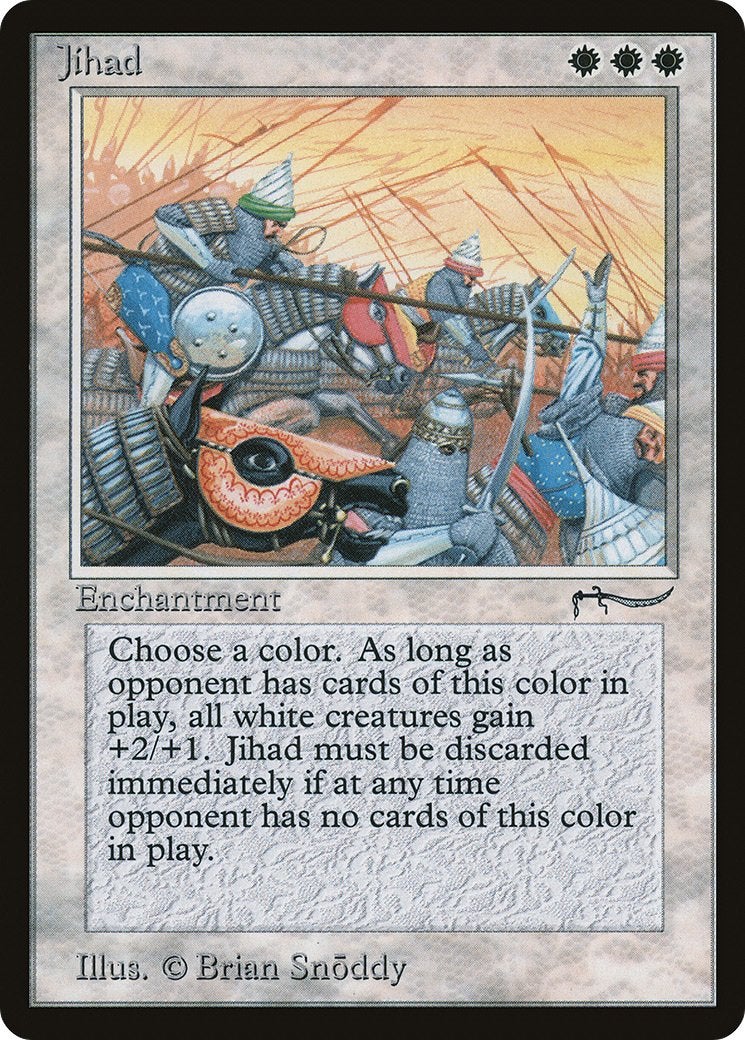
Based on the art and name, you’d immediately assume Jihad is among the more racist cards in MTG history. It was also released in 1993’s Arabian Nights expansion. Despite first appearances, this one falls more into the category of what we’re calling “retroactive racism.” The term “jihad” did not strike the same chord in 1993 as it does today.
In modern-day, the word “jihad” is synonymous with terrorist attacks. However, this Arabic term has multiple meanings—none of which mean what terrorists use it for today. In our article about the Jihad MTG card, we go into depth about this topic. Check it out if you want the full details! To summarize: “jihad” is an Arabic word that means “strive,” “effort,” or “struggle.” It refers to internal mental struggles, actual wars waged between groups of people, and more.
With that said, we get why Wizards of the Coast banned this one. The term has become such a bitter one—particularly in the West—that banning Jihad is a sensible call from a public relations standpoint. As such, Jihad lands on our list in the second least offensive spot.
Pradesh Gypsies
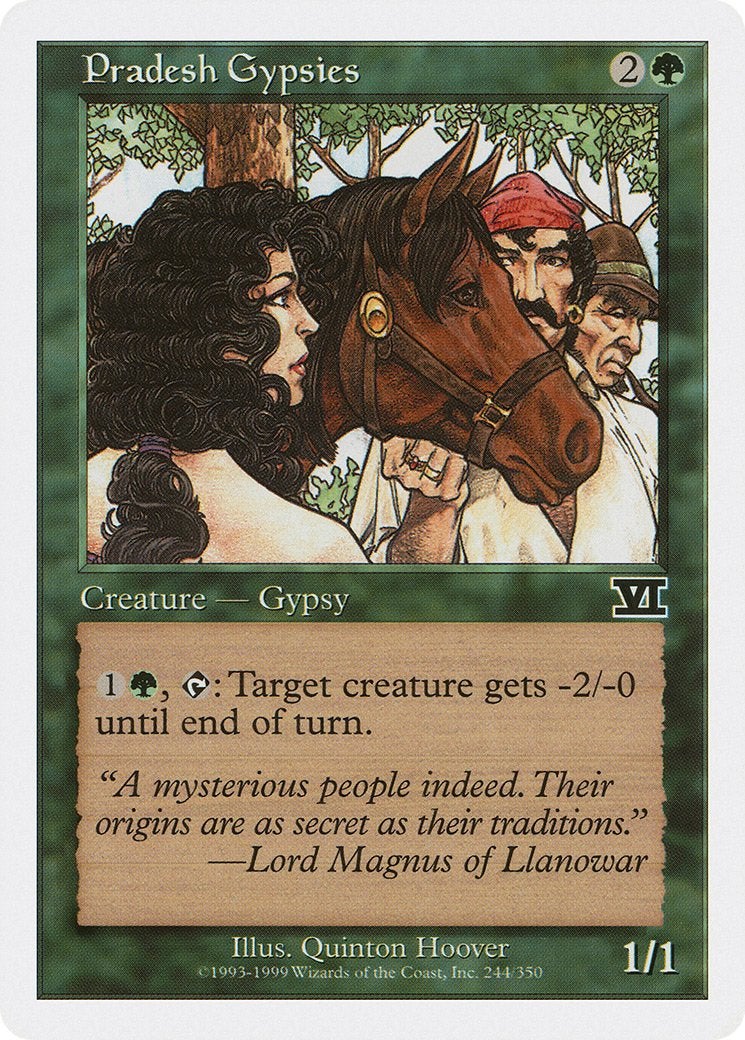
Alright, here’s where the true racist cards begin in MTG. Pradesh Gypsies was originally released in the Legends expansion in 1994. To start, “gypsy” is a racial slur for the Romani people. The Romani are a group originally from northwest India who have traveled through Asia and parts of northern Africa until they reached Europe. While a large concentration of the Romani population remains in Europe, some have found their way to the Americas.
Depicting Romani people on cards that also have text about them being “mysterious” and secretive (not the Alpha version, but on the Fixth and Sixth Edition ones) buys into cultural stereotypes that the world could do without. The Romani travel a lot, as is their custom, but don’t deserve to be depicted as weirdos tied to a history of odd traditions. While offensive, keep in mind we’ve got way more inappropriate subject matter to cover in this list.
Due to this card being genuinely offensive—but not as much as those below—Pradesh Gypsies lands in the number five spot.
Imprison
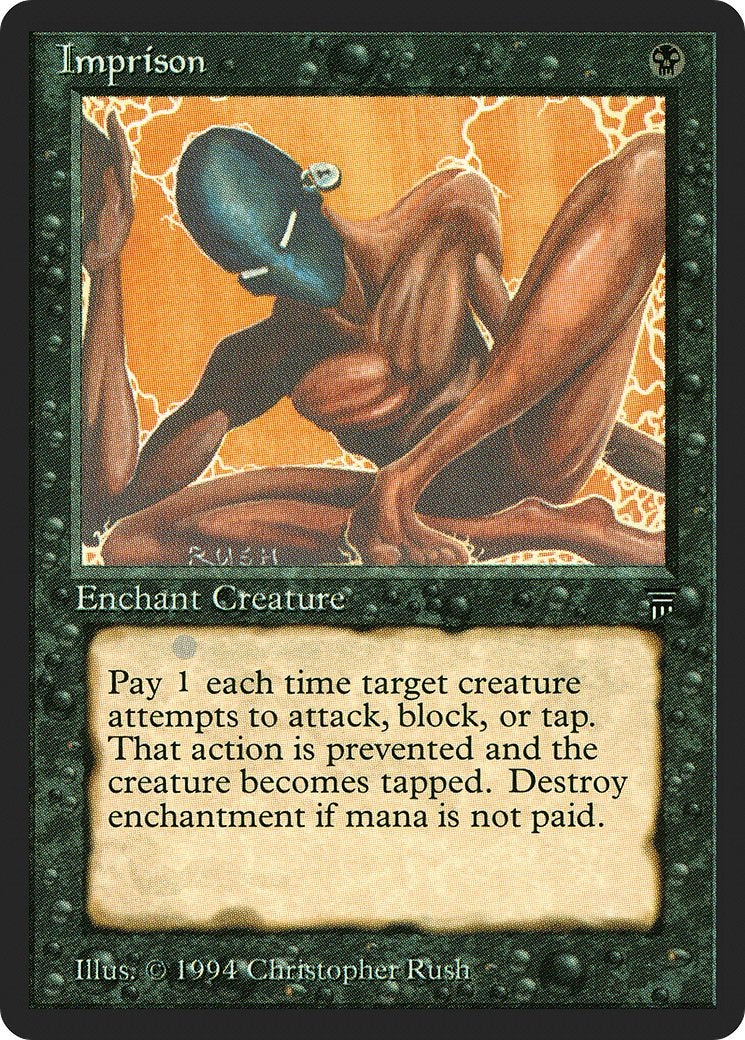
Like Pradesh Gypsies, Imprison was released in the Legends expansion in 1994. In terms of naming and effects, it’s fine. However…the art…oh boy. Depicting an emaciated dark-skinned person with a metal helmet locked onto their head? Wow. Back when slavery was a dominant feature in the United States, it was not uncommon to see African American slaves forced to wear similarly horrendous helmets as a form of containing and punishing them.
Usually referred to historically as an iron slave bit—or brank—this metal helmet originated from a device (a Scold’s Bridle) used to humiliate and harm women who were accused of being a witch. Even if the person in that art of the Imprison card wasn’t dark-skinned, it would still be offensive. This type of torture gear only belongs in a museum; not on an MTG card.
For reminding us that humans do horrible things to each other on the slightest whim, Imprison makes it to the middle of our list. What could be worse? Well, read on fellow MTG fans. You’ll soon find out.
Crusade
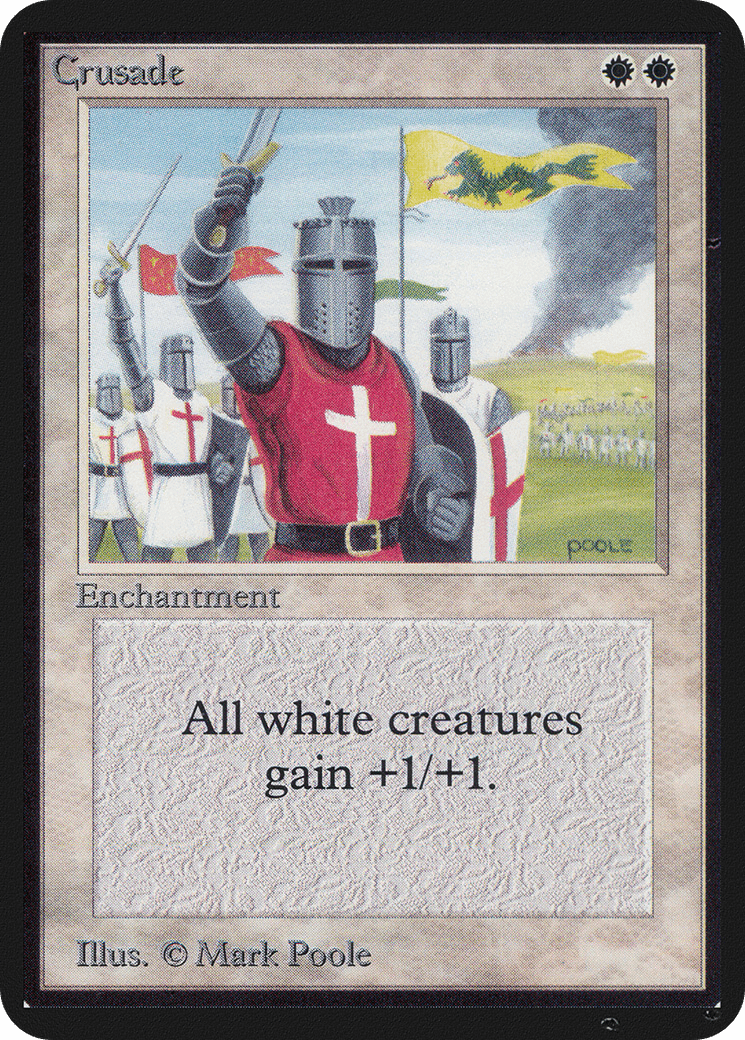
Crusade is a card from the Alpha set released in 1993. “White power” has a very different meaning in MTG than it does outside of it—we’ll get that notion addressed and out of the way immediately. With that said, when you have a card called Crusade depicting only templars with an effect that increases the power and toughness solely of white creatures accompanied by a burning building in the background…it feels like a call to arms for Neo-Nazism.
Despite the aforementioned issue, in-universe, there are rational explanations for everything on this card. By definition, a “crusade” is “a remedial enterprise undertaken with zeal and enthusiasm.” This is not inherently a racist concept but does have racist connotations. Especially if you think about the Crusades from the 11th, 12th, and 13th centuries where Christian powers waged war against Muslims over possession of “the Holy Land.”
Since the Crusade MTG card can be considered a direct reference to the Crusades, there’s a lot of religious strife connected to it. As a result, we’re dubbing it the third most offensive banned card in Magic: The Gathering.
Cleanse
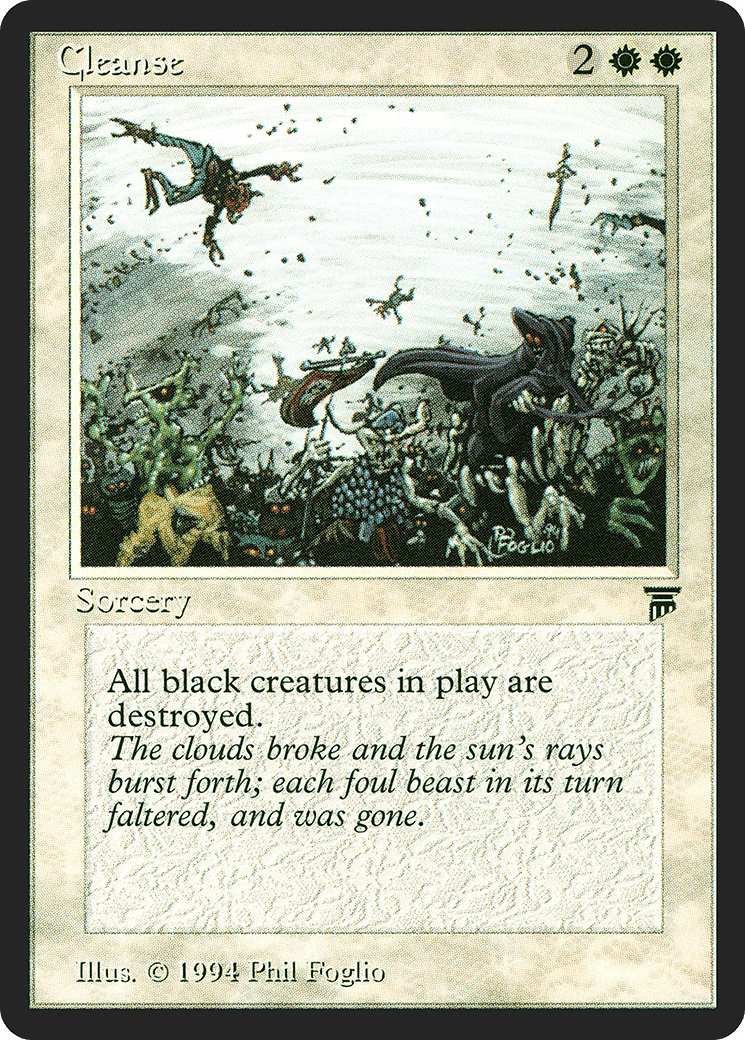
Cleanse is yet another racist MTG card from the Legends expansion released in 1994. It’s a white sorcery that destroys all black creatures. You can see how people find this one offensive without needing any explanation.
To clarify, all the black creatures depicted in this card’s art are non-human. You see skeletons and goblins for the most part. These creatures are often found within the black mana coloring, so that’s not racist by itself.
What denotes this card as being offensive is the correlation of this effect with the word “cleanse” as this is a bit too close to the concept of “ethnic cleansing.” This term refers to the extermination of minorities. As such, framed alongside effect text like “Destroy all black creatures” and said black creatures being referred to as “foul beast[s]” in the flavor text, it paints a brutal picture that reminds people too much of real-world genocides.
For being negligent of real-world tones this card can evoke, Cleanse reaches the penultimate spot on our list.
Invoke Prejudice
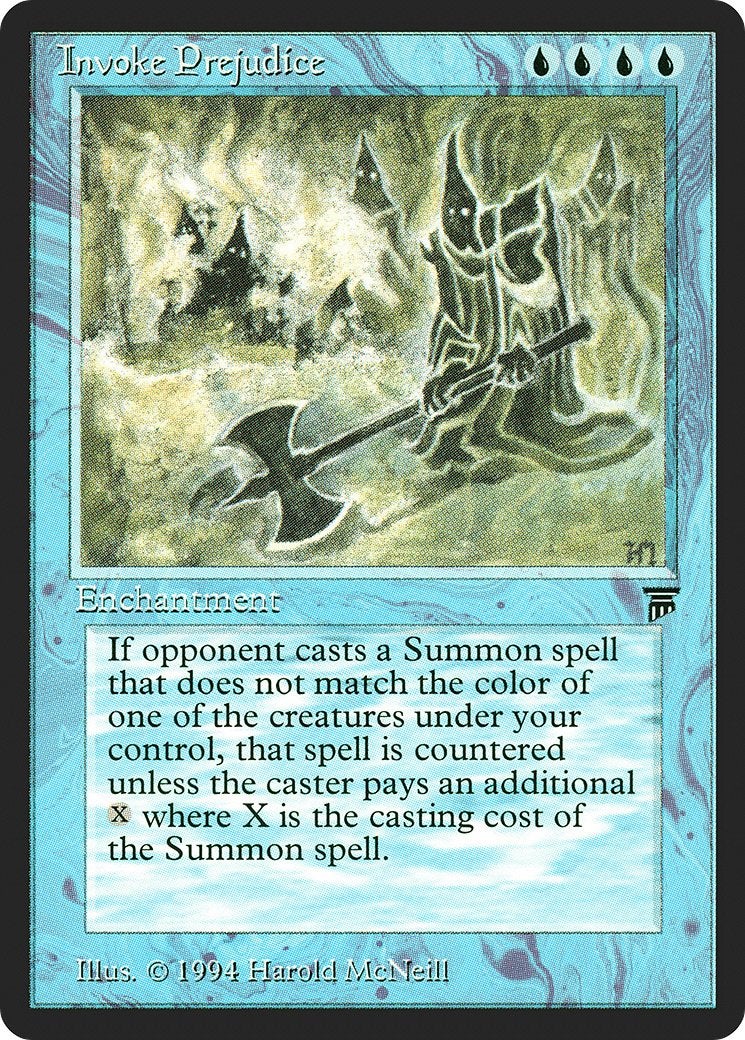
For those of you about to argue that the figures on this card are not meant to look like members of the KKK: get your eyes checked. Invoke Prejudice is another of the banned cards from the Legends expansion released in 1994. It is arguably the most racist, out of the offensive MTG cards, ever printed.
Firstly, a short history lesson. Pointed hoods worn along with robes existed before the KKK. However, this infamous white supremacy group stole this wardrobe choice from the Confraternity of Penitents because they liked this religious group’s intense practices. Shoutout to Blasphemous and Blasphemous 2.
Next, look at the card’s effect text. This is a clear reference to prejudice against those of other colors. It’s definitely an in-universe tie to the five mana colors. On top of that, it’s also drawing direct parallels to real-world racism. That’s why the hooded KKK-like figures are there; it’s not a coincidence.
Then, you have to consider that the Legends expansion is all about tying into myths, folklore, and fairy tales from the real world—like references to Halloween and The Legend of Sleepy Hollow. As such, it’s not only possible but probable—and even likely—that the figures on this card are meant to be literal KKK members.
Lastly, look at the artist’s credit: it’s Harold McNeill. Although McNeill is a talented artist, a lot of his work outside of MTG heavily features white supremacy imagery, pro-Nazi motifs, misogyny, and other concepts that would not be welcome in (modern) MTG art. Furthermore, some of these influences leaked into his MTG work…as you can see from Invoke Prejudice.
For more information about this card, including its sales price, check out our full article about Invoke Prejudice.
About McNeill’s Prejudice
Many sources are claiming that McNeill is openly prejudiced, which seems credible. We could not find a direct quotation from the man himself about this, but search “Harold Arthur McNeill” and see for yourself what comes up. We’re not going to link the search results here. We’d rather avoid association with such individuals. If you do look up McNeill’s artwork, be warned: what you’ll find is not for the faint of heart.
We love MTG but hate that its legacy has been tainted by a few racist cards. We’re not blaming Wizards of the Coast, as they did ban these cards…eventually. Times change, as does what the general public considers appropriate for gaming media. Thankfully, WotC decided to keep up with the times. The alternative would have led to a dark era for tabletop gaming.
Let’s be grateful that those in charge keep making improvements. That way, we can all enjoy MTG together—as it was meant to be. Furthermore, let’s also appreciate that they occasionally ditch boring and convoluted mechanics. Like how they abandoned the Banding mechanic over twenty years ago. Hooray for progress!


